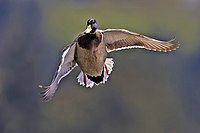Duck hunters asked to help monitor spread of Avian Flu
Tuesday, November 28, 2006
Virginia duck and goose hunters, and waterfowl hunters in other parts of the U.S., might for the first time find themselves approached by state game officials who are testing harvested birds for the presence of Avian Flu.
The Virginia Department of Game and Inland Fisheries (VDGIF) announced last week, at the start of the waterfowl hunting season, that it is working cooperatively with the U.S. Department of Agriculture and Interior in its national strategy to monitor the spread of the pathogenic strain of Asian H5N1 among migratory birds. Species of particular interest are the brant, tundra swan, mute swan, mallard, and snow goose.
VDGIF staff are in the field checking popular hunting spots, waterway boat ramps, and wildlife management areas where returning hunters may be asked to allow them to perform a swab test on bagged birds. The VDGIF press release says the procedure only takes seconds to perform, and those who bagged 3 birds of the targeted species can call the department to have someone come check the birds.
Avian Flu first surfaced in Asia in 2003. It is uncertain what factors contribute to the spread of the disease, but newer strains of H5N1 are more communicable than earlier recognized strains. "Although the spread of H5N1 in Asia has been primarily due to movement of domestic birds, the movement of this virus into wild birds raised the possibility that these species may also spread the virus," the U.S.Department of the Interior found in its March 2006 interagency strategic plan for early detection of the disease. It was found that Avian flu moved into wild birds and caused mortality among species of barheaded geese, brown-headed gulls, black-headed gulls, ruddy shelducks, and great cormorants in China in 2005.
The migratory flyways considered most at risk of disease transmission are on the Pacific side of the Americas in Alaska and the Pacific NorthWest, closest to Asia. The Atlantic flyway shares migratory influence from Europe and Africa where the Avian Flu has also been found.
A low pathogenic strain of H5N1 that currently exists in North America is common among waterfowl. Testing for the more virulent strains involves swabbing the bird's throat or rectum.
Sources
edit- A.J. Hostetler. "State game officials enlist help of hunters" — Richmond Times-Dispatch, November 27, 2006
- John Driscoll. "Front line flu watch" — The Times-Standard, November 26, 2006
External links
edit- "An Early Detection System for Highly Pathogenic H5N1" — U.S. Department of Interior, March 14, 2006 PDF format
- Press release. "VDGIF Conducts Surveillance for Avian Influenza in Waterfowl" — Virginia Department of Game and Inland Fisheries, November 20, 2006
